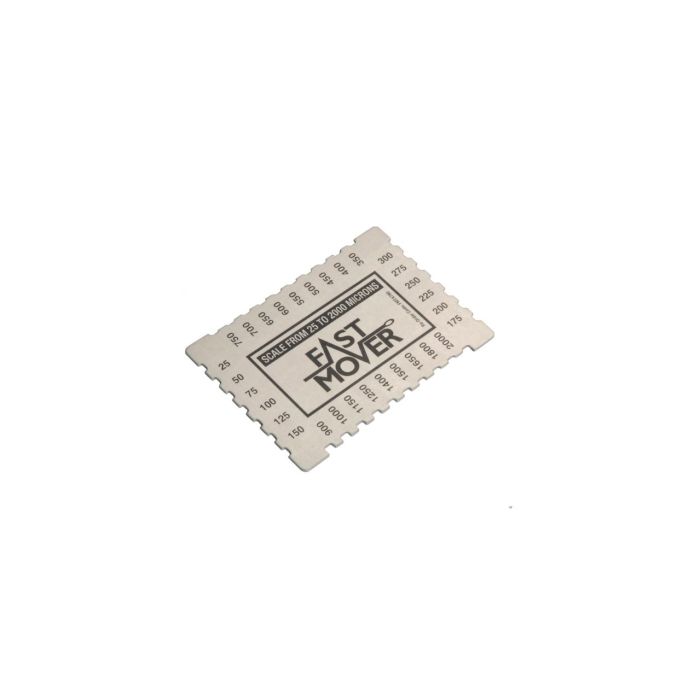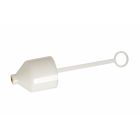|
Why use a Wet Film Thickness Gauge. 90 To 2000 Microns
|
|
|
|
1. Ensures Accurate Coating Thickness
|
|
|
|
Measures the actual thickness of wet coatings immediately after application.
|
|
|
|
Helps confirm you're applying the correct film build, which directly affects the coating’s performance.
|
|
|
|
|
|
|
|
2. Prevents Coating Failures
|
|
|
|
Too thin: May cause poor coverage, early failure, corrosion, or UV damage.
|
|
|
|
Too thick: Can lead to cracking, sagging, improper curing, or wasted material.
|
|
|
|
The gauge helps strike the right balance.
|
|
|
|
|
|
|
|
3. Ideal for a Wide Range of Applications
|
|
|
|
90–2000 microns covers everything from light primers to heavy-duty industrial coatings, such as:
|
|
|
|
Marine coatings
|
|
|
|
Protective epoxy systems
|
|
|
|
Tank and pipeline coatings
|
|
|
|
Fire-retardant and insulating paints
|
|
|
|
Concrete and steel protective coatings
|
|
|
|
|
|
|
|
4. Verifies Application Against Specification
|
|
|
|
Ensures compliance with manufacturer specs or industry standards (e.g., NACE, SSPC, ISO).
|
|
|
|
Important for quality assurance, especially in regulated industries (construction, infrastructure, oil & gas).
|
|
|
|
|
|
|
|
5. Reduces Material Waste
|
|
|
|
Prevents over-application of expensive coatings by applying only what's needed.
|
|
|
|
Saves cost and improves environmental responsibility.
|
|
|
|
|
|
|
|
6. Simple, Durable, and Easy to Use
|
|
|
|
Compact, handheld tool – just press against the wet surface to read the coating depth.
|
|
|
|
No power or calibration required.
|
|
|
|
|
|
|
|
7. Useful in Field or Shop Environments
|
|
|
|
Used by:
|
|
|
|
Painters and coating applicators
|
|
|
|
Inspectors
|
|
|
|
Quality control technicians
|
|
|
|
Contractors and engineers
|
|
|
|
|
|
|
|
The benefits of a Wet Film Thickness Gauge. 90 To 2000 Microns
|
|
|
|
1. Ensures Accurate Coating Thickness
|
|
|
|
Measures the wet paint or coating immediately after application.
|
|
|
|
Confirms whether the applied layer meets the manufacturer's recommended thickness before it dries.
|
|
|
|
|
|
|
|
2. Prevents Coating Defects and Failures
|
|
|
|
Too thin? Risk of poor coverage, corrosion, or early degradation.
|
|
|
|
Too thick? Risk of cracking, wrinkling, slow curing, or sagging.
|
|
|
|
Helps avoid costly rework or premature coating failure.
|
|
|
|
|
|
|
|
3. Wide Application Range
|
|
|
|
The 90 to 2000 micron range covers everything from light architectural coatings to heavy industrial coatings, including:
|
|
|
|
Epoxies
|
|
|
|
Fireproofing systems
|
|
|
|
Marine and offshore coatings
|
|
|
|
Tank linings
|
|
|
|
Protective coatings for steel and concrete
|
|
|
|
|
|
|
|
4. Supports Dry Film Thickness (DFT) Calculations
|
|
|
|
When combined with the paint's % solids by volume, it helps predict final DFT:
|
|
|
|
DFT=WFT×(%solids100)\text{DFT} = \text{WFT} \times \left( \frac{\% \text{solids}}{100} \right)DFT=WFT×(100%solids )
|
|
|
|
Essential for meeting coating specs in regulated industries (e.g., oil & gas, infrastructure).
|
|
|
|
|
|
|
|
5. Reduces Material Waste
|
|
|
|
Prevents over-application, saving money on expensive coatings.
|
|
|
|
More environmentally responsible application with fewer emissions and waste.
|
|
|
|
|
|
|
|
6. Simple, Fast, and Reliable Tool
|
|
|
|
No batteries, calibration, or setup required.
|
|
|
|
Just press the gauge into the wet coating to get an instant reading.
|
|
|
|
|
|
|
|
7. Enhances Quality Control and Compliance
|
|
|
|
Frequently used by:
|
|
|
|
Painters and applicators
|
|
|
|
Quality inspectors
|
|
|
|
Contractors and project managers
|
|
|
|
Ensures project documentation and QA/QC compliance with industry standards (ISO, SSPC, NACE, etc.).
|
|
|
|
|
|
Uses and applications of a Wet Film Thickness Gauge. 90 To 2000 Microns
|
|
|
|
1. Industrial and Protective Coatings
|
|
|
|
Ensures correct thickness of heavy-duty coatings like:
|
|
|
|
Epoxies
|
|
|
|
Polyurethanes
|
|
|
|
Zinc-rich primers
|
|
|
|
Coal tar and elastomeric coatings
|
|
|
|
Applied on steel, concrete, or industrial equipment to resist corrosion, chemicals, and abrasion.
|
|
|
|
|
|
|
|
2. Oil, Gas, and Marine Industry
|
|
|
|
Used in the application of protective coatings on:
|
|
|
|
Pipelines
|
|
|
|
Storage tanks
|
|
|
|
Offshore platforms
|
|
|
|
Ship hulls
|
|
|
|
Ensures compliance with specifications to protect from saltwater, chemicals, and extreme environments.
|
|
|
|
|
|
|
|
3. Architectural and Commercial Painting
|
|
|
|
Confirms proper wet film build for latex, acrylics, or intumescent coatings on walls, ceilings, and structural steel.
|
|
|
|
Ensures coatings meet fireproofing and durability standards.
|
|
|
|
|
|
|
|
4. Fireproofing and Intumescent Coatings
|
|
|
|
Critical in applying intumescent paints used to provide fire resistance.
|
|
|
|
These coatings require precise thickness to meet fire safety ratings.
|
|
|
|
|
|
|
|
5. Concrete and Masonry Coatings
|
|
|
|
Ensures even application of sealants, waterproofing membranes, or coatings over:
|
|
|
|
Basements
|
|
|
|
Bridges
|
|
|
|
Parking decks
|
|
|
|
Industrial floors
|
|
|
|
|
|
|
|
6. Quality Control and Inspection
|
|
|
|
Used by inspectors, quality control technicians, and contractors to verify coating specs during application.
|
|
|
|
Supports documentation and certification for compliance with industry standards (e.g., ISO, SSPC, NACE).
|
|
|
|
|
|
|
|
7. Laboratory and R&D
|
|
|
|
In paint labs or R&D settings, used to test and calibrate new formulations for desired film build characteristics.
|
|
|
|
|
|
|
|
8. Pre-Dry Film Thickness (DFT) Estimation
|
|
|
|
Helps estimate dry film thickness by factoring in paint’s solids by volume:
|
|
|
|
DFT=WFT×(%solids by volume100)\text{DFT} = \text{WFT} \times \left( \frac{\% \text{solids by volume}}{100} \right)DFT=WFT×(100%solids by volume )
|
|
|
|
|
|
|
|
Common Users
|
|
|
|
Industrial painters
|
|
|
|
Coating inspectors
|
|
|
|
Maintenance crews
|
|
|
|
Painting contractors
|
|
|
|
QA/QC professionals
|




